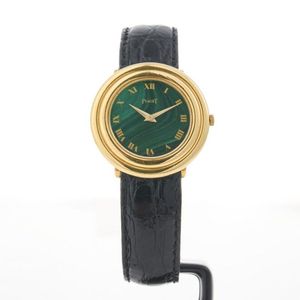18ct yellow gold, 32 mm ladies Piaget Ronde wristwatch. Model…
18ct yellow gold, 32 mm ladies Piaget Ronde wristwatch. Model reference 9046 18ct yellow gold case, features a screwed case back, cache lugs, 18ct yellow gold stepped bezel, and a signed malachite Roman numeral dial. Sapphire crystal, manual winding movement. Zrc black strap with original Piaget 18ct yellow gold pin buckle. Finished weight 32.00 grams inclusive of strap.
You must be a subscriber, and be logged in to view price and dealer details.
Subscribe Now to view actual auction price for this item
When you subscribe, you have the option of setting the currency in which to display prices to $Au, $US, $NZ or Stg.
This item has been sold, and the description, image and price are for reference purposes only.
- Bezel - On a clock or watch, the bezel is the metal frame into which the watch or clock glass is fitted. In clocks, the bezel may include a hinge and a flange, in effect a door to the face of the clock. In jewellery the bezel is a band of metal with a projecting lip that holds the gemstone in its setting.
- Movement - The technical name for the workings of a clock or watch, and does not include the dial or case.
- Malachite - Malachite is bright copper-green coloured stone with concentric layers which displays distinct contrasting veinings. It has been valued in the past for making or decorating small precious objects such as clocks, jewellery, dishes and so. In the Orient it was used for snuff bottles and in Russia and was favoured by the Faberge workshop. larger pieces were used for table tops.
The principal source of supply was Russia but it is to be found in other regions such as Southern Africa, Mexico, Australia and France.
Malachite glass is a manufactured material that was intended to resemble malachite, but often bears more resemblance to a veined coloured marble due to its lower gloss finish and lack of concentric layers. Malachite glass was manufactured by many glassworks in the 19th century including Loetz in Austria and others in Bohemia and Davidson's Greener's and Sowerby in north eastern England.
It was particularly used for scent bottles, bowls, and small vases often decorated with nymphs.
Malachite glass has been manufactured continuously since the late nineteenth century, most is unmarked and it is difficult to distinguish the age or manufacturer of most commercial pieces.
This item has been included into following indexes:
